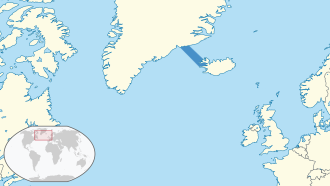Denmark Strait overflow

The Denmark Strait overflow (Danish: Grønlandspumpen; Norwegian: Grønlandspumpa, meaning "the Greenland pump") is an undersea overflow located in the Denmark Strait between Greenland and Iceland. The overflow transports around 3.2 million m3 (110 million cu ft) of water per second, greatly eclipsing the discharge of the Amazon River into the Atlantic Ocean and the flow rate of the former Guaíra Falls.[1][2] The descending column of water is approximately 200 m (660 ft) wide and 200 m (660 ft) thick and descends over a length of around 1,000 km (620 mi).[2] It is formed by the density difference of the water masses either side of the Denmark Strait; the southward-flowing water originating from the Nordic Seas is colder and consequently more dense than the Irminger Sea to the south of the strait. At the Greenland–Iceland Rise – an elevated ridge forming the overflow's apex – the colder water cascades along the seafloor to a depth of around 3,000 m (10,000 ft).[3] Due to the Coriolis effect, the downward flow of water is deflected to the right, resulting in the descending water on the Greenland side of the channel being roughly 1 km (0.62 mi) higher than the opposite side of the channel.[2]
The overflow provides one of the main inflows of North Atlantic Deep Water, accounting for around half of dense water overflow between the Nordic Seas and the North Atlantic.[4][5] The dense and cold water mass that spills across the overflow, known as Denmark Strait Overflow Water (DSOW), is thought to originate from the modification of water masses in the eastern Nordic Sea, the Greenland Sea, and the Iceland Sea.[1] The North Icelandic Jet and two branches of the East Greenland Current transport the dense water to and across the overflow.[6][7] DSOW is a key component of the present-day thermohaline circulation and may influence the Atlantic Multidecadal Oscillation.[8][9]
Although undersea overflows are usually not considered "waterfalls", the Denmark Strait overflow would be tallest waterfall in the world, with water falling over 3.5 km (2.2 mi); this descent is over three times the height of Angel Falls, the world's tallest uninterrupted waterfall over land.
References
- ^ a b Saberi, Atousa; Haine, Thomas W. N.; Gelderloos, Renske; Femke de Jong, M.; Furey, Heather; Bower, Amy (August 1, 2020). "Lagrangian Perspective on the Origins of Denmark Strait Overflow". Journal of Physical Oceanography. 50 (8): 2393–2414. doi:10.1175/JPO-D-19-0210.1. hdl:1912/26690.
- ^ a b c Whitehead, John A. (February 1989). "Giant Ocean Cataracts". Scientific American. 260 (2): 50–59. doi:10.1038/scientificamerican0289-50. JSTOR 24987139.
- ^ "Where is Earth's Largest Waterfall?". National Ocean Service. Retrieved June 20, 2023.
- ^ Jochumsen, Kerstin; Quadfasel, Detlef; Valdimarsson, Heðinn; Jónsson, Steingrímur (December 2012). "Variability of the Denmark Strait overflow: Moored time series from 1996-2011: DENMARK STRAIT OVERFLOW". Journal of Geophysical Research: Oceans. 117 (C12). doi:10.1029/2012JC008244.
- ^ Käse, R. H.; Girton, J. B.; Sanford, T. B. (June 2003). "Structure and variability of the Denmark Strait Overflow: Model and observations". Journal of Geophysical Research: Oceans. 108 (C6). doi:10.1029/2002JC001548. ISSN 0148-0227.
- ^ Morozov, Eugene G.; Tarakanov, Roman Y.; Frey, Dmitry I. (2021). "Flows Through the Northern Channels in the North Atlantic". Bottom Gravity Currents and Overflows in Deep Channels of the Atlantic Ocean: 443–477. doi:10.1007/978-3-030-83074-8_9.
- ^ Almansi, M.; Haine, T. W. N.; Gelderloos, R.; Pickart, R. S. (February 28, 2020). "Evolution of Denmark Strait Overflow Cyclones and Their Relationship to Overflow Surges". Geophysical Research Letters. 47 (4). doi:10.1029/2019GL086759. hdl:1912/25815.
- ^ Jonsson, Steingrimur (2004). "A new path for the Denmark Strait overflow water from the Iceland Sea to Denmark Strait". Geophysical Research Letters. 31 (3). doi:10.1029/2003GL019214.
- ^ Kösters, F.; Käse, R. H.; Schmittner, A.; Herrmann, P. (February 2005). "The effect of Denmark Strait overflow on the Atlantic Meridional Overturning Circulation: DENMARK STRAIT OVERFLOW AND AMO". Geophysical Research Letters. 32 (4). doi:10.1029/2004GL022112.